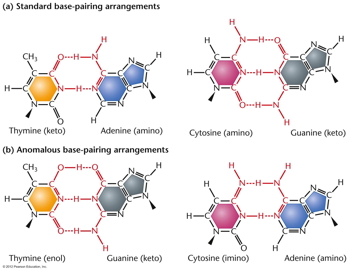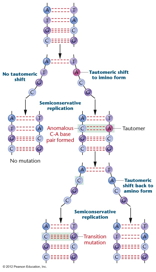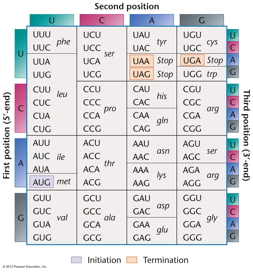"Gene Mutations" refer to
changes that occur to the genetic material at the DNA level.
- Chemical
Nature of the Change to the DNA Molecule: Errors in
DNA replication or other events can ultimately result in these
kinds of chemical changes to the DNA.
- Base Substitutions (Point Mutations): The
substitution of one base for another. If not corrected, a
base substitution will become a base-pair substitution. SNPs
(single nucleotide polymorphisms) are marker point mutations
that have been mapped across the human genome and are useful
in hunting for unknown genes. The average human germline
base substitution rate is 1.28-2.2 x 10−8/bp/generation
(Lynch 2010, PNAS 107, 961; 2005, Nature
437, 69).
- Transitions: This is when a purine is
substituted for a purine or a pyrimidine is substituted
for a pyrimidine.
- Transversions: This is when a purine is
substituted for a pyrimidine or a pyrimidine is
substituted for a purine.
- Base Insertions and Deletions and Indels: An
error of replication may add or skip a nucleotide or several
nucleotides (small indels). In human, the rate of small
indels (1 to 20 bp) has been estimated to be
2.94/genome/generation (Kloosterman et al. 2015, Genome
Res. 25, 792).
- Causes
of These Changes: Several events can cause
such a chemical change to the DNA.
- Replication Errors and Slippage: DNA
polymerase can make various errors resulting in base
substitution or insertions and deletions.
|
- Tautomeric
Shifts:
If a rare tautomer of a base is present during
replication, it can result in a base substitution. (keto
<--> enol
and amino
<--> imino)

|
 |
- Chemical Modification of Bases: The bases
can be chemically modified in numerous ways:
- Depurination: Some
agents (like water!) cause the removal of a purine from
a strand of DNA.
- Deamination:
An amino group may be
removed from a base.
- Oxidation:
Oxygen may be added to a base.
- Alkylation:
An alkyl group (hydrocarbon chain like a methane or
something longer) is added by alkylation.
- Intercalation:
Some chemicals can slip right between adjacent bases,
causing trouble during DNA replication.
|

|
- Base
Analogs: Some chemicals are so
similar to natural bases that they can be incorporated in
place of one of the normal bases.
|
|
- Ionizing
Radiation: As described in the previous
outline, ionizing radiation, like X rays, can create
reactive ion pairs which in turn react with DNA to
chemically modify it. X rays particularly cause DNA
single-strand and double-strand breaks.

|
- Ultraviolet
Light: UV changes DNA by creating
covalent bonds (thymine dimers) between two thymines that
line in sequence on a DNA strand.
|
 |
|
|
|
|
 |


